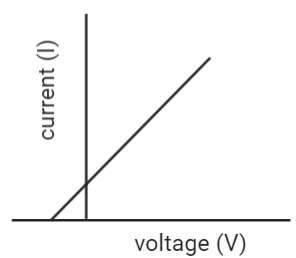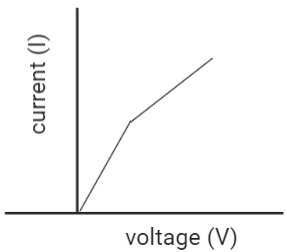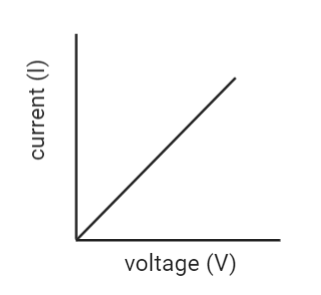
Which of the V-I graph obeys Ohm’s law?
A)

B)

C)

D)





Answer
573k+ views
Hint: Here we have to discuss the diagrammatic representation of Ohm’s law and variation of current with respect to voltage.
Complete step by step solution:
As per Ohm’s law, the current flowing in a circuit is directly proportional to the applied potential difference and inversely proportional to the resistance in the circuit at constant temperature.
V=IR where V is the voltage, I is the current and R is the resistance.
In other words, it can be written as I= V/R. In this question, we have to compare the variation of voltage and current graphically.
If we plot voltage on the x-axis of a graph and current on the y axis of the graph, we get a straight line as follows.

Option A: Voltage and current increases by the same amount. In the first option, the line is intercepted on the negative x axis which is not possible.
Option C: As voltage increases current does not increase up to a certain level, then suddenly there will be increase in current along with voltage which is not possible according to Ohm’s law.
Option D: The variation of current and voltage is not increasing by the same amount which is again not possible as per Ohm’s law.
Therefore, option B is the correct answer.
Note: Ohm’s law states that the resistance of a conductor is constant provided its physical conditions, such as temperature, remains constant. But as we increase the voltage across the conductor, it will heat up according to I2R and so the temperature of it is increasing, so technically even if it turns out to display I proportional to V, we can’t say it obeys Ohm’s law because Ohm’s law needs its temperature to remain constant.
Complete step by step solution:
As per Ohm’s law, the current flowing in a circuit is directly proportional to the applied potential difference and inversely proportional to the resistance in the circuit at constant temperature.
V=IR where V is the voltage, I is the current and R is the resistance.
In other words, it can be written as I= V/R. In this question, we have to compare the variation of voltage and current graphically.
If we plot voltage on the x-axis of a graph and current on the y axis of the graph, we get a straight line as follows.

Option A: Voltage and current increases by the same amount. In the first option, the line is intercepted on the negative x axis which is not possible.
Option C: As voltage increases current does not increase up to a certain level, then suddenly there will be increase in current along with voltage which is not possible according to Ohm’s law.
Option D: The variation of current and voltage is not increasing by the same amount which is again not possible as per Ohm’s law.
Therefore, option B is the correct answer.
Note: Ohm’s law states that the resistance of a conductor is constant provided its physical conditions, such as temperature, remains constant. But as we increase the voltage across the conductor, it will heat up according to I2R and so the temperature of it is increasing, so technically even if it turns out to display I proportional to V, we can’t say it obeys Ohm’s law because Ohm’s law needs its temperature to remain constant.
Recently Updated Pages
Master Class 12 Business Studies: Engaging Questions & Answers for Success

Master Class 12 Economics: Engaging Questions & Answers for Success

Master Class 12 English: Engaging Questions & Answers for Success

Master Class 12 Maths: Engaging Questions & Answers for Success

Master Class 12 Social Science: Engaging Questions & Answers for Success

Master Class 12 Chemistry: Engaging Questions & Answers for Success

Trending doubts
What are the major means of transport Explain each class 12 social science CBSE

Which are the Top 10 Largest Countries of the World?

Draw a labelled sketch of the human eye class 12 physics CBSE

How much time does it take to bleed after eating p class 12 biology CBSE

Explain sex determination in humans with line diag class 12 biology CBSE

Differentiate between homogeneous and heterogeneous class 12 chemistry CBSE




